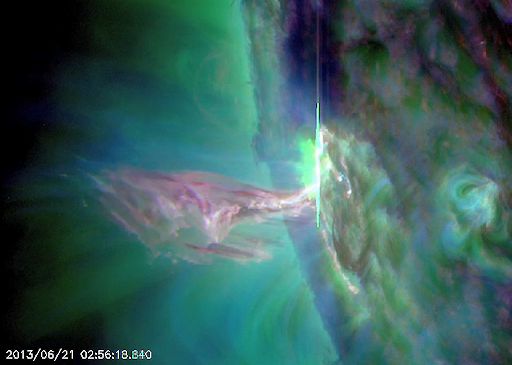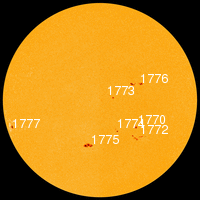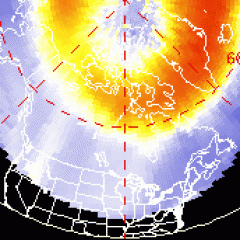SUMMER SOLSTICE: Today is the first day of northern summer. At 1:04 a.m. EDT on June 21st, the sun reached its highest point on the celestial sphere (declination = +23.5o) marking the start of summer in the northern hemisphere, and winter in the south. Happy solstice!
SOLSTICE SOLAR FLARE: This morning, June 21st at 03:16 UT, the sun itself marked the solstice with an M2-class solar flare from sunspot AR1777. NASA's Solar Dynamics Observatory photographed the extreme ultraviolet flash and a plume of material flying out of the blast site:
As sunspots go, AR1777 is neither large nor apparently menacing, yet it has been crackling with flares for days. Before it rotated over the sun's eastern limb on June 20th, it unleashed a series of farside flares and CMEs. Today's explosion was not Earth directed, but future explosions could be as the sun's rotation continues to turn AR1777 toward our planet. NOAA forecasters estimate a 30% chance of M-flares and a 5% chance of X-flares during the next 24 hours. Solar flare alerts: text, voice.

Solar wind
speed: 378.0 km/sec
density: 2.2 protons/cm3
explanation | more data
Updated: Today at 1547 UT
X-ray Solar Flares
6-hr max: C3 0931 UT Jun21
24-hr: M2 0316 UT Jun21
explanation | more data
Updated: Today at: 1500 UT
![]()
Daily Sun: 21 Jun 13
Sunspots AR1775 and 1777 pose a threat for M-class solar flares. Credit: SDO/HMI
![]()
Sunspot number: 128
What is the sunspot number?
Updated 21 Jun 2013
Spotless Days
Current Stretch: 0 days
2013 total: 0 days (0%)
2012 total: 0 days (0%)
2011 total: 2 days (<1%)
2010 total: 51 days (14%)
2009 total: 260 days (71%)
Since 2004: 821 days
Typical Solar Min: 486 days
Update 21 Jun 2013
The Radio Sun
10.7 cm flux: 128 sfu
explanation | more data
Updated 21 Jun 2013
![]()
Current Auroral Oval:
Switch to: Europe, USA, New Zealand, Antarctica
Credit: NOAA/POES
![]()
Planetary K-index
Now: Kp= 2 quiet
24-hr max: Kp= 4 unsettled
explanation | more data
Interplanetary Mag. Field
Btotal: 10.2 nT
Bz: 2.7 nT north
explanation | more data
Updated: Today at 1547 UT
![]()
Coronal Holes: 21 Jun 13
Solar wind flowing from this coronal hole could brush against Earth's magnetic field on June 22-24. Credit: SDO/AIA.






Comments
Sun Rotation
You mentioned in your report about the sun rotation. Is this a fixed axis rotation or a combination of that with some orbital rotation as well?